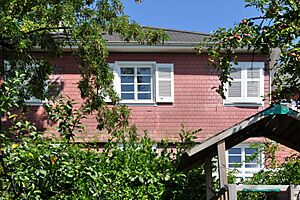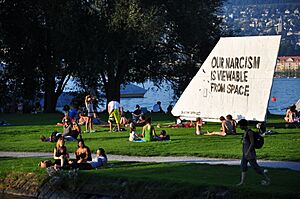Alliance F facts for kids
| Founded | 1899 |
|---|---|
| Focus | Federation of Swiss women's associations, since 2011 known as alliance F |
| Location | |
| Origins | Women's suffrage in Switzerland |
|
Area served
|
Switzerland |
| Website | alliance F |
alliance F is a group of women's associations in Switzerland. It used to be called the Federation of Swiss Women's Associations (BSF in German, ASF in French). This organization works to support women and make sure their voices are heard.
Contents
History of alliance F
Early Beginnings
At the end of the 1800s, leaders of women's groups in cities like Bern, Zürich, Lausanne, and Geneva started working on issues like education and laws affecting women. In 1896, they held the first Swiss women's meeting. They wanted to bring all women's groups together under one big organization.
Three years later, in 1899, they officially formed the Federation of Swiss Women's Associations, known as BSF. Their goal was to encourage each other, influence political decisions, and represent Swiss women in the global women's movement.
Growing Influence
Besides the founding groups, other associations joined, including teachers' groups. By 1945, about 250 women's associations were part of the BSF. Since 1903, the BSF has been the main organization representing Switzerland in the International Council of Women (ICW).
When the Swiss Civil Code (a set of laws) was being created, the BSF tried to make sure women had more control over their property. They also worked to improve the rights of children born outside of marriage.
Fighting for Rights
The BSF focused on creating new laws. They supported movements for better morals and worked on the new Penal Code. They also pushed for laws to protect mothers and ensure women were included in health insurance and old-age insurance (AHV).
Even though a new group was formed for women's right to vote, the BSF strongly supported this cause after 1909. They also focused on women's jobs, education, and home economics. They looked into working conditions in factories and service jobs. The BSF tried to stop the unfair treatment of female workers by working on laws about housework and factory work.
Education and Support
The BSF believed that home economics should be a required subject in Swiss schools. They also wanted domestic work to be seen as a real profession. In 1923, they helped open the Swiss Central Office for women's careers. This office gave advice and also influenced politics.
During the difficult years between the two big European wars, women's jobs were at risk. However, the success of the SAFFA exhibition in 1928 helped. During World War II, the BSF worked with national defense and helped with care and nutrition. This made them a key partner for the government. The BSF also represented Switzerland in international women's groups, like the League of Nations and later UNESCO.
Moving Towards Equality
In 1949, the BSF changed its rules to include mixed-gender organizations, like women's suffrage clubs. They also brought in the Swiss Federal women's secretariat, which started in 1943.
The campaign for "Equal pay for equal work" and the SAFFA exhibition in 1958 were very important. SAFFA 1958 promoted a "three-phase model" for women: education and a job, then motherhood and family, and finally returning to work. These efforts helped bring more equality between women and men during a time of economic growth. The BSF focused on improving women's public standing and bettering laws about childhood and marriage.
SAFFA Exhibitions


The SAFFA (Swiss Exhibition for Women's Work) was a big event organized by the BSF.
SAFFA 1958
From July 17 to September 15, 1958, the BSF led the second SAFFA exhibition. Over 1.9 million people visited it! More than a hundred women's organizations from all over Switzerland took part. The exhibition was held on the Landiwiese in Zürich-Wollishofen.
Before the exhibition, an artificial island called Saffa-Insel was built. This island is still a popular place today, used as a swimming area in summer and for events like the Zürcher Theater Spektakel.
The main architect for the 1958 exhibition was Annemarie Hubacher-Constam. The theme was "Life circle of women in family, occupation, and country." SAFFA showed women the possibilities in education, jobs, shopping, and free time. It promoted the "three-phase model" as an ideal path for women: work before marriage, motherhood, and then returning to the job market.
The exhibition also aimed to make men understand how important women's contributions were to society. The money earned from the two SAFFA exhibitions (1928 and 1958) was used to create support programs for women.
Future SAFFA Plans
In February 2007, the Swiss government signed an agreement to fully recognize women's human rights in Switzerland. An online platform called frauennet.ch suggested organizing a third SAFFA. They even held women's picnic brunches on the Saffa-Island in Zürich to promote the idea.
However, the project couldn't start right away due to money issues. Later, alliance F, the Federation of Swiss women's organizations, began preparing for a third SAFFA. They created an association called «2020» for this purpose. They launched a project called «2020 – der weibliche blick auf die zukunft» (which means: 2020 - the female view of the future). This project aims to gather ideas and visions for the future of society from women's perspectives and share them with the public. A first online presentation happened in 2013, starting the work towards SAFFA 2020.
Organization and Profile
After 1970, the BSF faced some challenges and lost some of its influence. This was partly because its newspaper, Schweizer Frauenblatt, stopped publishing. Also, the organization was seen as being a bit stuck in traditional ideas about gender roles. Even the fourth and fifth Swiss women's congresses in 1975 and 1996 didn't fully stop this trend. The Federal Commission for women's issues took over some of the BSF's roles.
In 1986, the BSF's office moved to Worblaufen, near the archives of the Swiss women's movement (the Gosteli Stiftung). This move helped give the BSF new energy.
Renaming to alliance F
In 1999, the BSF decided to change its name to alliance F. The fifth Swiss women's congress, "Women 2001," created a working group called Arbeitsgemeinschaft Frauen 2001 (Argef 2001). This group wanted to update the "three-phase model" from 1958. They supported the "Ticino Model," which helps women balance paid work and motherhood by providing good pre-school and primary school education across the country.
Member Organizations
As of November 2014, alliance F includes more than 150 member organizations from all over Switzerland.
Key People
Here are some important people who have been part of alliance F (or BSF):
- Emma Pieczynska-Reichenbach (co-founder)
- Camille Vidart (co-founder, board member until 1908)
- Emma Boos-Jegher (co-founder, vice president 1912–1916)
- Helene von Mülinen (co-founder, president 1900–1904, board member until 1920)
- Pauline Chaponnière-Chaix (co-founder, president 1904–1910 and 1916–1920)
- Klara Honegger (co-founder, president 1911–1916)
- Elisabeth Zellweger (president 1920–1929)
- Anne de Montet-Burckhardt (president 1929–1935)
- Clara Nef (president 1935–1944)
- Adrienne Jeannet-Nicolet (president 1944–1949)
- Gertrud Haemmerli-Schindler (president 1949–1955)
- Denise Berthoud (president 1955–1959)
- Dora Julia Rittmeyer-Iselin (president 1959–1965)
- Rolande Gaillard (president 1965–1971)
- Jacqueline Berenstein-Wavre (president 1975–1980)
- Sibylle Burger-Bono (president 1999–2005)
- Rosmarie Zapfl-Helbling (president 2006–2014)
- Maya Graf (co-president since)
- Elisabeth Nägeli (vice president 1939–1967)
- Jeanne Eder-Schwyzer (board member 1949–1957)
- Marthe Gosteli (board member 1968–1972)
- Marie Boehlen (chairwoman of the Legal Commission)
See also
- SAFFA
- Women's suffrage in Switzerland
Literature
- Silke Redolfi: Frauen bauen Staat. 100 Jahre Bund Schweizerischer Frauenorganisationen; 1900–2000. Verlag der NZZ, Zürich 2000, ISBN: 3-85823-819-8.
- Sibylle Brändli: Der Supermarkt im Kopf: Konsumkultur und Wohlstand in der Schweiz nach 1945. Böhlau Verlag, Wien 2000, ISBN: 9783205992646.
- Marie-Louise Barben, Elisabeth Ryter: Verflixt und zugenähnt. Frauenberufsbildung - Frauenerwerbsarbeit 1888 - 1988. Bern 1988, ISBN: 9783905278330.
- M. Beyeler: La SAFFA (Schweiz. Ausstellung für Frauenarbeit) de 1958 à Zurich: son architecture et ses architectes. Dissertation, Lausanne 1999.
- Dorothee Huber: Die Tugend der Not. Zu den beiden historischen Ausstellungen für Frauenarbeit (SAFFA 1928 und 1958). In: Ausstellungen - Darstellungen, Beiträge zum Diplomwahlfach "Frauen in der Geschichte des Bauens", Vol. 3, Petra Stojanik (pbl), Lehrstuhl Flora Ruchat-Roncati ETHZ, Zürich 1995.

